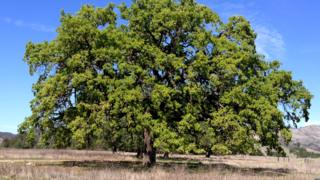Genetics can play key role in saving trees
Tree conservation strategies based on genetic data are best suited for landscapes affected by a rapidly changing climate, a study suggests….

 Image copyright V. Sork
Image copyright V. Sork Tree conservation strategies based on genetic data are best suited for landscapes affected by a rapidly changing climate, a study suggests.
Researchers found using genetic markers of climate resilient traits are more effective than traditional seed-selection methods.
The team also found that the current generation of trees are struggling to cope in current conditions.
The findings appear in the Proceedings of the National Academy of Sciences.
Co-author Prof Victoria Sork, from the department of ecology and evolutionary biology at the University of California, Los Angeles (UCLA) explained why the team of researchers felt there was a need to carry out the study.
“Trees, which are long lived, and climate change – which is happening quickly – could be out of sync with each other,” she explained.
“The question is that if they are out of sync with each other, how can we manage tree populations so that they can better cope with increased temperatures?”
21st Century conservation
Prof Sork said that current conservation strategies often worked on the assumption that plants were currently growing in conditions well-suited to the species.
However, the team found that this was not the case.
Prof Sork: “I became concerned about oak because it was a very important species for the ecosystem.
“When a site burns down, as we are getting an increasing number of fires, people will often replant to quickly re-establish the ecosystem that was destroyed.
“But the question is, are they planting the right seedlings?”
Writing in their paper, the researchers observed: ‘In California, valley oak (Quercus lobate) is already mismatched to current temperatures and will likely experience further declines in growth rate as temperatures rise over the next century.”
Failure to achieve optimal growth could leave the trees less resilient to future climatic conditions.
“The rapid climate change that we are seeing now, the reason trees are so vulnerable is because their lifespan exceeds the rate of climate change,” Prof Sork suggested.
She told BBC News that progressive forestry policies, suggest heading to the lowest latitude of a tree species range because these individual trees were most likely to carry traits that would make them more resilient to future warming.
However, this was not enough to cope with certain scenarios of future temperature rises, which were outside the range of temperatures the species had experienced in that region.
Moving forward
The team decided to see if genetic markers within the trees’ DNA that were associated with good growth under warmer climates could help identify the seeds that were best suited to warmer conditions in the future.
“The answer is yes,” stated Prof Sork.
“When you think about restoring a forest or replanting, what you could do is [genetically] scan trees and pick the seeds from trees that are associated with this growth.
“That’s what we have tested in the paper to see if such an approach would improve growth; the answer is yes.”


